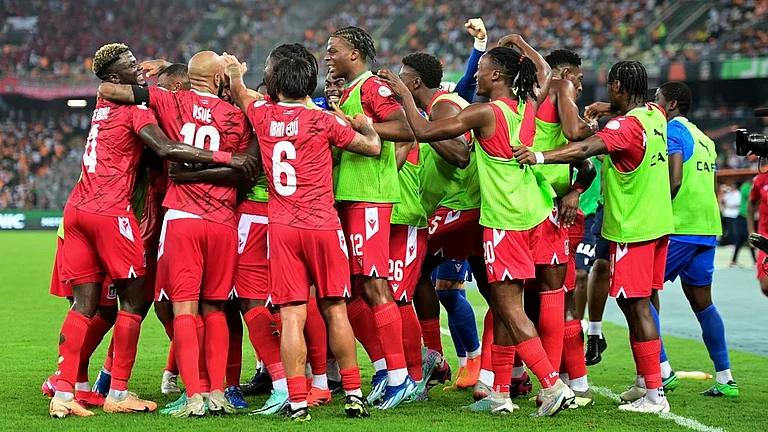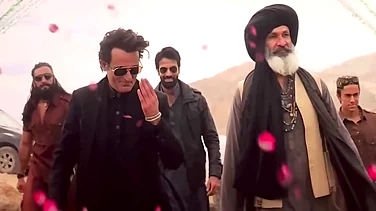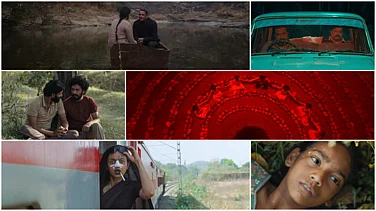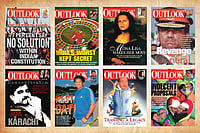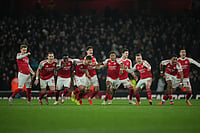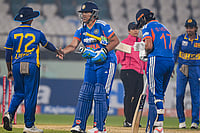TIMES were when what passed off for books on contemporary art in India were tackily produced, turgidly written, appallingly illustrated tomes from the bureaucratically bogged Lalit Kala Akademi or the dour-toned, academically-afflicted Oxford University Press (OUP).
Bombay painter Jehangir Sabvala recalls returning in the '50s from England to Bombay, to "a complete wilderness, zero visibility, no quality publications on contemporary Indian art". In a desperate bid to reach a larger public, Sabvala, and a few of his contemporaries, tied up with Vakeel's to reprint their work as Christmas and Diwali greeting cards. Those Rs 10 cards were the picture books—those cheap, virtually cyclostyled handouts from LKA and OUP, the art books of the era. An era when Pynes sold for Rs 200, Husains sold for Rs 300, when the contemporary Indian art mart was a Rs 30,000 a year business.
Well, times are a-changing. Today Husains and Pynes sell for Rs 10 to 20 lakh in what insiders assert is a Rs 20 crore a year art mart. One midwifed into existence by the publishing boom of the '70s that triggered off the Art Boom of the '80s. Inevitably this art market has spawned its own subsidiary: the multi-crore art book bazar. No less than 12 books on contemporary Indian art by premier Delhi, Bombay, Ahmedabad and foreign-based publishing houses like Penguin, Media Trans Asia, Marg, Mapin (in collaboration with the Heart Foundation) and Thames and Hudson, prestigious galleries like Chemould of Bombay and Vadehra's of Delhi—each costing between Rs 5 and Rs 50 lakh
ATUL LOKE to print and priced between Rs 550 and Rs 4,000—are being released in 1997 with all the hype and hoopla one associated with Hindi film premieres of the '50s.
Leading the vanguard: London School of Economics alumni Neville Tuli's magnum opus, The Flamed Mosaic, released this January—a 450-page, 200-colour plate, 100,000-word landmark work priced at Rs 4,000, co-published by Mapin and the Tuli-owned Heart Foundation, which Tuli asserts is the "first comprehensive look at 100 years of Indian painting, its aesthetic and philosophic underpinnings". Rumoured production cost: Rs 55 lakh.
Another major book released last week: art historian Geeti Sen's scholarly 164-page, 100-colour plate, glossy on Syed Haider Raza, the Paris-based minimalist painter from Bhopal. Price: Rs 1,600, production midwifed by Media Trans Asia scion and avid art collector Nitin Bhayana. Estimated production cost: Rs 25 lakh.
Other major works slated for a 1997 release: British painter Timothy Hyman's liberally illustrated, well written critical assessment of Baroda painter Bhupen Khakhar, to cost over Rs 2,000 and to be published by Chemould Art Gallery, Bombay. Production cost: Rs 30 lakh. Also, art critic Ranjit Hoskote's lavishly illustrated 200-page biographical assessment of Sabvala that includes a critical assessment by Speaking Tree author and Sabvala contemporary, Richard Lannoy. Expected price: Rs 2,000. Production cost: Rs 40 lakh. Meanwhile, Marg at Bombay is bringing out a 176-page, 101-colour plate book priced at Rs 1,750 titled Expressions and Evocations, Contemporary Women Artists of India and edited by Gayatri Sinha. Production cost: Rs 15 lakh.
That's just the tip of the iceberg. The Thames and Hudson publishing house in London is set to publish and promote its Rs 40-lakh book on contemporary Indian art. The Tulika publishing house of Delhi is readying to print Baroda painter Ghulam Sheikh's book on contemporary painters of the Baroda school as also a book on 'modern' Indian painters by art critic Geeta Kapur that should leave them with a Rs 15 lakh production bill. Meanwhile, Rakhee Sarkar of Seema Gallery, Calcutta, has teamed up with Penguin India to publish a book commemorating 50 years of Indian independence in which leading Indian painters have been asked to paint their impressions of the most momentous events they've experienced, ranging from the Partition to the Bhopal tragedy. Estimated production cost: Rs 20 lakh. The book launch later this year will coincide with an exhibition of the same works at Seema Gallery. OUP is readying to publish Yasodhara Dalmia's four-year-long labour of love on the Progressive Artists Forum: as the radical group of painters—Husain, Ara, Souza, Bhakre, Gade, who, in the early '50s revolutionised painting in India—are named. That's not the only work that has kept Dalmia busy. She's just finished editing and writing a Vadehra-produced book on contemporary Indian painters that includes essays on their work, superb reproductions, biographical sketches as well as an exhaustive bibliography. Price: Rs 2,000. Production cost: a hefty Rs 20 lakh.
And there's more to come. Menu 1998—two books from Mapin. Total cost Rs 35 lakh. One on painter Yusuf Arakal, another on contemporary painting and sculpture. Also, a Rs 20 lakh book on Husain's drawings to be published by Vadehra. Meanwhile, sensing blood, Delhi-based publisher Pramod Kapoor of Roli plans to enter the market the same year with a series of monographs on prominent Indian painters. Penguin India chief David Davidar confesses to thinking along the same lines.
Why are gallery owners and publishers risking Rs 2 crore plus on art books, always considered a no go hard-sell proposition till 10 years ago? Well, there's method in their madness. "Vadehra risks Rs 20 lakh on a book because on the strength of the interest generated he will be able to sell paintings worth five times more." says art critic Suneet Chopra. "It's a slow but sure investment," says Delhi's Village Gallery owner Dolly Narang. And lately a not so 'slow' investment, as Mapin's Bipin Shah and Neville Tuli of the Heart Foundation discovered to their delight. Initial print run of The Flamed Mosaic: 5,000 copies. Breakeven point for publisher: 50 per cent sales. Presold copies: 2,800. To business houses as diverse as Tatas, Jindals, even Deutche Bank. Booksellers are enthusiastic. "They're telling us it should be no problem selling a few thousand copies," Shah says contentedly.
Why this sudden surge of interest in contemporary Indian art? Hoskote puts it succinctly: "The art market is coming of age. The hurly burly of buying and selling, the Sotheby, Christie, Asprey auctions are behind us. We're now becoming sophisticated. Developing the international apparatus that goes with any informed market." Kapur agrees: "All that painters produced in aesthetic terms had to generate an equivalent critical practice". Tuli puts it best: "An informed accessible alternative to the stolid black and white OUP tome and the brassy, vulgar coffee table book had to emerge. It was time to fill the blanks." An inexcusable blank in Sabvala's opinion:
"People who went from exhibition to exhibition are realising that what goes into a painting is not paint alone but a whole process and are willing to invest in books that explain those processes, render the artist and image intellectually instead of just visually accessible to them."
Also comprehensible. What the new books, barring the dishonourable exceptions, offer is relief from incomprehensible jargonese. "Art academics can no longer talk only to each other. Critical acrobatics, verbal pyrotechnics, intellectual posturing are passe. What is evolving is a supple, flexible, highly intelligent idiom that does not intimidate but communicates to the reader and sustains his interest," says Hoskote. For the moment, art books are sustaining the intellectual interest of both the reader and the commercial interest of the publisher.









